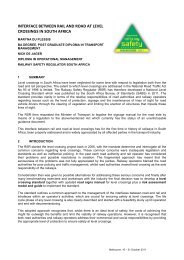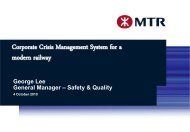successful interface risk management - International Rail Safety ...
successful interface risk management - International Rail Safety ...
successful interface risk management - International Rail Safety ...
Create successful ePaper yourself
Turn your PDF publications into a flip-book with our unique Google optimized e-Paper software.
Axel Kappeler, James Catmur<br />
Arthur D. Little<br />
Successful <strong>interface</strong> <strong>risk</strong> <strong>management</strong> – from blame culture to joint action<br />
In these circumstances, it is best to talk to each party separately. Each party is asked separately about the<br />
<strong>risk</strong>s they see at the <strong>interface</strong> – the <strong>risk</strong>s that their activities could cause others and the <strong>risk</strong>s they think<br />
others are causing them. The identified <strong>risk</strong>s are consolidated and entered into a <strong>risk</strong> register. In this<br />
approach it is important to preserve anonymity, i.e. you don’t tell party A which <strong>risk</strong>s were brought up by<br />
party B, which by C and which by D. The focus should be on agreeing that there is a <strong>risk</strong> and that it needs<br />
to be managed.<br />
3. Assessing <strong>interface</strong> <strong>risk</strong>s<br />
In the third step the identified <strong>interface</strong> <strong>risk</strong>s are assessed. Typical methods for assessing the likelihood and<br />
impact can be used, for example <strong>risk</strong> ranking matrices.<br />
Risk level<br />
Probability<br />
Probability<br />
Highly<br />
5 probable<br />
High<br />
>75%<br />
4 Probable<br />
50%-75%<br />
3 Possible<br />
25%-50%<br />
Medium<br />
2<br />
Low<br />
5%-25%<br />
Very Low<br />
1<br />
0-5%<br />
Low<br />
Very low Low Moderate High<br />
Very<br />
high<br />
1 2 3 4 5<br />
Severity<br />
x<br />
Severity<br />
Figure 3: Example <strong>risk</strong> ranking matrix<br />
4. Taking action to manage <strong>interface</strong> <strong>risk</strong>s<br />
In the fourth step action plans are developed to mitigate the <strong>risk</strong>s. One of the main challenges with <strong>interface</strong><br />
<strong>risk</strong>s is that the direct control of a <strong>risk</strong> can often not be attributed to one party alone or the party affected by<br />
the consequences of the <strong>risk</strong> is not the same party that causes (and often controls) the <strong>risk</strong>.<br />
Therefore, actions to mitigate the identified <strong>risk</strong>s need to be developed jointly by the parties and agreed.<br />
Each action should be conducted by the party that is best placed to take it. For each <strong>risk</strong> and action a<br />
Single Point of Accountability (SPA) should be nominated. The <strong>risk</strong> SPA is accountable that the <strong>risk</strong> is<br />
effectively managed – through one or several actions. The <strong>risk</strong> SPA does not need to be accountable for, or<br />
indeed carry out, all the actions, but he needs to make sure that the agreed actions are completed on time.<br />
The SPA should typically be a senior person, such as a department head, to provide sufficient focus and<br />
visibility. For actions the SPA can delegate responsibility for completing the action (e.g. to a person in his<br />
department or team) but remains accountable that the action is completed.<br />
This approach provides clarity and accountability for all sides as to who needs to do what by when to<br />
mitigate a specific <strong>risk</strong>.<br />
Note that for one <strong>risk</strong> more than one action may be identified or that one action may mitigate two or more<br />
<strong>risk</strong>s.<br />
Finally, the implementation of the actions needs to be monitored to check that they are being done and have<br />
the desired effect in mitigating the <strong>risk</strong>.<br />
London, 8 – 10 October 2012















